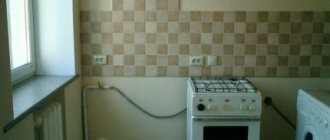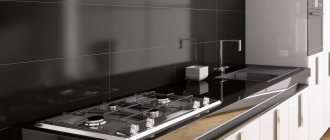Moving a kitchen into a living room is a difficult process, but possible. Such redevelopment can make living more comfortable by combining rooms and allocating an additional room.
Moving the kitchen into the room is popular not only in houses built last century, but even among homeowners in modern new buildings.
The main obstacle to achieving our plans is sanitary, building codes and standards. All information about the possibility of moving the kitchen is in the documents - SanPiN 2.1.2.2645-10 and SNiP 31-01-2003. Any actions require approval.
Relocating a kitchen using examples of different projects and layouts, as well as important nuances, can be seen in the video:
Let's consider when such redevelopment can and cannot be carried out.
Prohibited and allowed options
Cases when it cannot be transferred
- After the redevelopment, the kitchen space will be located directly under the bathroom of the neighbors above.
This option can work out if you increase the area of the new room due to the square meters of the bathroom by demolishing the partition.
There are exceptions here.
- This can be done if you have a two-story apartment.
- This can be done if you live on the top floor.
Kitchen moved to the living room along with communications
- After the redevelopment, under the new kitchen space there are living rooms for the neighbors.
There are exceptions here too.
- This can be done if you live on the first floor.
- This can be done if there is non-residential premises below you. As a rule, these are commercial premises on the first floors of apartment buildings. They can occupy one or two floors. With housing on the second or third floor, there is a chance to coordinate the project according to all the rules.
Kitchen in large living room. Water supply and sewerage are connected from the bathroom behind the adjacent wall
- The neighbors above the kitchen will have a toilet or bathroom.
It is good if the location of the new kitchen is close to the original location. Then it will be possible to avoid problems with the supply of sewerage, water supply and ventilation pipes.
- The kitchen is gasified.
It is impossible to remove the partition from the living room in a gasified room, because... According to the standards, it must be isolated. It is permissible to make sliding doors.
Exception: you can legally refuse gas in your apartment as a single person by submitting an application to the municipality. A special commission makes a decision on the reconstruction project and transition to a new tariff for electric stoves. After making changes to the technical plan, you can coordinate the time of work with gas services. The contract with old service providers is terminated and a new one is concluded with electricity suppliers.
- There will be access from the kitchen to the toilet or bathroom.
Transfer approval
If you are planning to move the stove, consultation with specialists from the gas service of your city is required. Any installation and dismantling work is carried out by specialists authorized for these actions. The transfer will not be carried out without agreement with the gas workers!
There are certain rules on how to obtain permission to move.
- Contact specialists by phone, they will give an initial consultation, after which you will probably have to fill out an application to transfer the equipment.
- After the application is written and submitted to the relevant structures, the approval process is launched. Based on your application, a specialist will come to your home (time to be determined).
- He inspects the kitchen, you voice your wishes regarding how far you are going to move the stove from the main installation location. If you have previously studied the requirements and standards for gas pipeline installation, many points are omitted.
- The specialist approves the final scheme for transferring the slab and draws up an estimate. The paperwork is handled by the organization that will move the slab. If the homeowner does not agree, no work is carried out.
- If the transfer conditions proposed by the specialist suit you, then using the receipt provided you need to pay for the services and agree on the day of the transfer.
As for the timing, the approval procedure will take 5-10 days. The problem is postponed for a long time if the apartment owners do not agree to the proposals of the gas service employees. But a compromise will have to be found, and it always fits within the framework of the standards. The distance from the wall to the slab cannot be reduced to circumvent the requirements. Unauthorized transfer is a violation of the law; fines cannot be avoided in this case.
Private buildings on one floor
How to legalize the transfer of the kitchen to the living room? This question worries everyone who has started remodeling an apartment. When it comes to a private home, there are no problems. Previously, they were required to collect a certain list of documents, which included a permit from the gas supply organization, the consent of all co-owners, a project with confirmed sanitary standards and registration of the Unified State Register of Real Estate (formerly BTI).
At the beginning of 2021, a law came into force that greatly facilitates the approval of redevelopment in private homes. To obtain permission, just contact the MFC. After this, all documents will be transferred to the territorial housing inspection.
Is the neighbor a controlling “authority”?
Exactly.
The housing inspectorate, the management company and even other residents have the right to initiate proceedings regarding illegal redevelopment. A statement from a vigilant neighbor to the BTI, or even the prosecutor's office, is enough for a competent inspection to come. It is better not to bring the situation into conflict with the law by agreeing on the upcoming work in advance.
You can learn how to properly legalize redevelopment in an apartment by watching the video:
Share this post
Discussion: 3 comments
- Ivan says: 06/08/2019 at 13:39
Many transfers and redevelopments can cause security threats to other residents of this house. Are there any rules regarding criminal punishment for officials who gave permission for the reconstruction of an apartment, which then caused damage to the entire house?Answer
- Nikolay says:
07/31/2019 at 08:23I don’t understand, if the kitchen is gasified, then you can’t demolish the partition, but sliding panels can. What good are these sliding doors if there is a gas leak? Can they compare with a solid solid wall, of course not.
Answer
- Oleg says:
01/16/2020 at 16:09How should a tenant act if he suspects that one of the apartments in his building is undergoing renovation work with the demolition of major partitions? Do the owners of such an apartment have a right not to let a local police officer inside if he doesn’t have a warrant?
Answer
General rules
Any change in the position of utility networks in the apartment is a redevelopment. If a sewerage system is being transferred, all actions must be roughly divided into 2 stages:
- approval of redevelopment, obtaining permission to carry out work;
- execution of the technical part.
The relocation of sewerage in the apartment must be approved by the BTI and other authorities. Without going into details, we note the complexity of this procedure. First, you need to do a survey of the premises and consult with specialists. It is necessary to find out to what extent the proposed changes are possible and acceptable.
Secondly, you will need a detailed plan for the upcoming changes. It needs to be approved, then the work will have to be coordinated with the architecture department, etc. Officials or responsible persons are reluctant to accommodate apartment owners who want to make drastic changes. There are clearly defined rules:
- moving the sewer riser in the apartment is prohibited. Several restrictions apply simultaneously here regarding property rights (the riser belongs to common property of the house) and technical ones (changing the configuration of utility networks is prohibited). In addition, the placement of wet rooms above the living rooms of neighbors below is prohibited by housing legislation;
- It is prohibited to destroy or reduce the size of load-bearing walls. Similar actions are often carried out when combining two apartments or joining a kitchen to a room;
- if the kitchen is moved into the living room, the sewer may leak and flood the neighbors below. Regardless of whether the flood occurred in a residential or auxiliary premises, claims will arise against the culprit.
Given these difficulties, officials try not to take risks and do not give permission to carry out the work. The consequences of improperly performed sewerage relocation may affect the person who gave permission for this step. Moreover, the rules talk about changes in the general sewerage system of the house, and these include any work.
Therefore, before installing a sewer system in an apartment to another room, you should critically consider your plan and weigh its weaknesses. If there are too many of them, it is better to look for other, less problematic options. This will help save time, money, and eliminate unpleasant conversations with neighbors.
Conclusion
Relocating a kitchen is a painstaking process that requires mandatory prior approval and the participation of many specialists. During repairs, you will need to contact the BTI, the Moscow Housing Inspectorate, the management company, and sometimes Mosgaz and Mosenergo.
Before starting the redevelopment, we recommend that you contact APM-1 for a consultation so that you have a clear understanding of what stages are important not to skip and what preliminary work in the apartment needs to be done in your case, because each redevelopment is individual.
Leave a request for a free consultation on apartment redevelopment
Zamyatin Dmitry Alekseevich
Zamyatin Dmitry Alekseevich
General Director of LLC "APM-1" Design workshop PEREPLAN.
Education: Higher technical (Master's degree from Moscow State University of Civil Engineering)
Specialization Coordination of redevelopment of commercial and residential real estate in Moscow and St. Petersburg
In what case is permission given to move the kitchen into the room?
When studying all the regulations, it seems that it is simply impossible to obtain a work permit. However, it is not. Although there are numerous prohibitions, moving a kitchen is quite possible. In what cases will the law be on the side of the apartment owner?
- The location of the housing on the ground floor allows you to move the kitchen to any room. The main thing is to clarify that basements are not considered residential.
- Owners of apartments on the top floor are allowed to move communications towards the bathroom or toilet.
- If there is a pantry or hallway under the kitchen, then it is quite possible to obtain permission for redevelopment.
- In multi-level apartments, you can move the kitchen space to any rooms on the second floor.
- If shops, cafes and other non-residential premises are located under the apartment, then redevelopment is permitted without any restrictions.
In addition to the above, you need to pay attention to one more important point. Even if you comply with all points, you can get a refusal if the room is less than 8 m2
There are also certain temperature requirements. It should be in the range from 18 °C to 26 °C.
The concept of a “wet zone”
What a “wet zone” is is not precisely stated anywhere in the legislation. This is a colloquial concept known to realtors and developers, under which all areas in an apartment where water supply and sewerage systems are present are united.
So, what is considered a wet area in an apartment? Wet areas include:
- bathroom;
- toilet;
- combined bathroom;
- shower;
- kitchen.
Is the kitchen considered a wet area in the apartment? This issue should be considered in more detail. The kitchen is a place where, in one way or another, water supply and drainage systems are present.
There is always a sink there, and often a washing machine or dishwasher. The kitchen is a wet area only if it contains these objects associated with the flow of water.
According to some sources, the wet zone covers the point itself plus 2 meters around it; according to other sources, the wet zone corresponds to the entire room with partitions.
Most often, it is the kitchen that apartment owners want to move to other rooms or somehow expand the kitchen area existing from the developer. The wet area area must have a waterproofing layer that prevents water and sewage from leaking into the rooms on the lower floors.
In typical multi-storey buildings, the layout of apartments is determined in such a way that the kitchens are located above and below the kitchen, and the bathrooms of the neighbors are located above and below the bathroom. A different arrangement of rooms is fraught with serious emergencies, floods and violations of sanitary standards.
Normative base
In current realities, there is no separate law that would prohibit the transfer of a wet zone in an apartment. Before deciding to move the wet zone in an apartment, you need to study the basic standards and rules for the operation of residential premises in apartment buildings.
In fact, all rules and standards apply specifically to apartment buildings due to the presence of neighbors in them. In a private house, a citizen has the right to move rooms in any order at his discretion.
Basically, all issues relating to the redevelopment of premises are set out in the following documents:
- SNiPs - building codes and regulations;
- SP - sets of rules;
- Decrees of the Government of the Russian Federation.
It is difficult to say unambiguously whether these documents have the status of laws. According to some sources, they are rather advisory in nature. However, in practice, their violation can threaten the apartment owner with serious liability.
To clearly answer the question of whether it is possible to move a wet area in an apartment, you need to refer to SNiP 01/31/2003 “Residential multi-apartment buildings” or SP 54.13330.2011 “Residential multi-apartment buildings”.
The rules for transferring wet zones are contained in Decree of the Government of the Russian Federation No. 47 “On approval of the Regulations on recognizing premises as residential premises, residential premises unsuitable for habitation and an apartment building as unsafe and subject to demolition.”
How to move a gas stove?
Gas stoves are the most common appliance in our kitchens. They began installing such units more than a hundred years ago, and housewives immediately appreciated the convenience of gas-powered stoves. Of course, modern models are very different from their “great-grandmothers”; they have acquired more functions, become safer and more convenient to use. They also retained the common feature of all gas stoves - durability. When used correctly, plates rarely fail.
But for all their reliability, gas stoves are considered high-risk devices. Violation of operating rules threatens with extremely serious consequences. That is why, reconstruction related to the transfer of gas stoves requires a permit.
When renovating a kitchen space, it often becomes necessary to place the stove in a different location. If the stove is electric, then the owner can carry out the rearrangement himself and no permits are required for such alterations. When moving a gas stove, it becomes necessary to lengthen the gas pipeline pipes to ensure gas supply. You are not allowed to carry out such work yourself. Only a specialist from the Gas Service can intervene in the gas pipeline.
To do this, you will need to arrange a call from a specialist to your home. Immediately inform the model and brand of your stove, such forethought will save time. Otherwise, the technician who comes to the call may not have the necessary parts with him, and will have to issue the call again.
Since the location of the gas stove is marked on the BTI plan, its movement will be considered a redevelopment. Therefore, it is necessary to obtain permission for the reconstruction in advance.
However, you should know that when issuing permits, the Housing Inspectorate is guided by current standards, and if they are violated, approval will be denied. For example, you decided to carry out a redevelopment by dismantling the partition between the kitchen and the adjacent room. If the apartment is one-room, then redevelopment may be prohibited on the grounds that it is not allowed to place gas appliances in residential premises. And if the partition is dismantled, there will not be a single room left in the apartment that will be considered residential. However, in some areas such redevelopment is allowed provided that the kitchen area is separated from the living room by a light movable partition. If the apartment has two or more living rooms, then, as a rule, there are no problems with obtaining permission.
There may also be difficulties in coordinating redevelopment, which includes moving the kitchen into the living room. Such redevelopment can only be permitted if there are no residential premises under your apartment. The approval of such a reconstruction takes place according to the project, in which, among other things, the extension of the gas pipeline must be calculated. This section of the project must be approved by the City Gas Authority.
As for the cost of approval of the redevelopment, which consists of moving the gas stove, it includes two components - payment to the Gas Service, whose specialists carry out the repairs, and payment for approval by the Housing Inspectorate.
Moving a gas stove itself is not difficult and can be done by the owner himself. Craftsmen will need to pay for supplying gas to the stove. How much will such a service cost? This depends on how far from the gas pipeline the stove is now located. If the movement is insignificant, you will simply need to replace the hose through which the gas is supplied with a longer sample. This service is inexpensive. At longer distances, it will be necessary to connect additional pipes to the gas pipeline, which is more complex work and, accordingly, costs more. Typically, the services of the Gas Service to move the slab cost 1000-3000 rubles.
Coordination of such redevelopment in some departments of the Housing Inspectorate is free of charge. But there are areas where you have to pay for such approval; the amount of the receipt that will need to be submitted to the inspection department is 2,000 rubles.
To avoid unpleasant surprises during approval, it is better to get a preliminary consultation on whether the planned redevelopment complies with the rules and regulations.
Slab placement
The stove can be positioned so that the approach to it is comfortable and safe. This applies to both standard stoves and modern hobs.
There are several recommendations that are useful to familiarize yourself with before starting redevelopment.
- A gas hob or a separate stove should be placed at an interval of 50 cm from windows or doors. Moving the stove to the window is unacceptable. The prescribed distance cannot be reduced without permission. If a draft occurs, it can lead to the ignition of flammable objects or, on the contrary, it will extinguish the flame with the gas on.
- The stove should be located strictly near the gas distribution and ventilation compartment, with free access to the shutoff valve.
- If you are replacing a gas model with an electric stove, the wiring must be powerful.
- You cannot place a gas stove in the corner near the refrigerator - just like in any other place next to refrigeration equipment.
Refrigerator next to stove
The heat from the stove inevitably forces the refrigerator to work more powerfully. The warmer it is, the more cold the compressor produces. The device itself is technically designed for strict time intervals for auto-shutdown of the compressor. When external temperatures rise, the compressor literally works into overdrive to maintain the desired temperature.
As a result, equipment breaks down faster. And if the stove is on almost all the time, then even modern appliances break down ahead of time. On average, five years after purchasing a refrigerator, if it is operated next to a stove, fatal breakdowns occur. Repairs can be so expensive that owners think about buying new equipment.
Sink next to the stove
Many owners are sure that such a neighborhood is harmless, and even convenient, but this is not so. If you have an electric stove, then the border zone with the sink is always a risk of a short circuit. If you have a gas stove, there is a risk of explosion.
Also, do not discount burns to the skin and mucous membranes caused by boiling oil. If you are washing dishes and meat is being fried on the stove next to you, for example, then water that gets into the pan can actually cause a burn. The greater the distance between the stove and the sink, the more comfortable the cooking process.
Apartment redevelopment
A kitchen combined with a living room is a very rare occurrence, but undoubtedly, an original
kitchen can be moved to a corridor, living room or other room (depending on the features of the house plan). In most cases, kitchens with an area of less than 10 square meters are moved. m. The transfer process is quite complicated both in terms of coordination and implementation, because it is necessary to transfer and connect utilities to existing pipelines, and also take care of ventilation.
For example, to ensure gravity flow of sewage, pipes must be laid at a slope. The required slope angle will be quite difficult to achieve when moving the kitchen to distant rooms. In addition, it can be difficult to route sewer pipes without getting into doorways. If, for similar reasons, it is not possible to provide the proper slope, a sewage pump is used. Its use makes it possible to install a sewerage system without a slope. The only drawback is its cost.
Built-in household appliances
The modern market for household appliances offers a huge selection of all kinds of household appliances. Typically, equipment is divided into built-in and free-standing. To understand what the difference is, you need to take a closer look at each type separately.
In addition to the fact that the built-in oven looks more attractive, it is endowed with better heat protection. Manufacturers of such ovens make protection from external heat more reliable. Depending on the model and brand, heat-resistant cardboard or a layer of conventional insulation is used as insulation. Models with triple glass doors also play an important role in insulating heat from the external environment. Also, modern models are equipped with a fan and an emergency shutdown function, which makes the use of these devices safer.
An example of the placement of built-in equipment.
The built-in refrigerator is also not deprived of thermal insulation, thanks to additional finishing panels.
Thus, the thermal protection of built-in ovens and refrigerators allows them to be placed in the kitchen space the way the owner wants, without worrying about the safety of operation and serviceability of the appliances. If we rely on reviews from owners of built-in appliances, we can conclude that such devices are equipped with high-quality thermal insulation, which makes it possible to safely install household appliances next to each other.
This option for placing built-in equipment is quite acceptable
Ventilation
Redevelopment of the apartment provides for additional ventilation. Initially, the channel is installed taking into account the size of the room and direct draft. When transferring, you will have to use pipes and boxes that will redirect the air flow. The traction deteriorates significantly if the structure is equipped with a large number of turns, and is also located at a large distance from the channel. For example, after 10 meters you will need to use forced ventilation. For this purpose fans are installed
It is important to understand that the vent cannot go into other rooms
A few more important nuances
- Ventilation. It is required in the new premises, but moving it is the most problematic part. It is not advisable to move the kitchen if you have to pull the ventilation pipe more than 10 meters. The craving will decrease. Additional fans will be required. This is not the best idea for an apartment with a low ceiling.
It is also useful to read: Review of hoods for the kitchen without venting to the ventilation.
- Temperature conditions. Permissible temperature is 18-26 degrees Celsius. In cold weather – 19-21 degrees.
- The natural light ratio is also important. Its value is from 0.5. The new location must have sufficient lighting. It is not allowed to erect blind partitions that will block the window to the street.
- It is not recommended to carry the water supply far. This is fraught with a decrease in pressure due to the large horizontal extent. The pipes are hidden under the floor or in a drywall box.
- The cross-section of sewer pipes is larger than water pipes. Considering that they must run at a slope, the floor under which they are hidden will have to be raised. An idea for apartments with sufficient ceiling heights.
- It is worth taking into account the load of the electrical network and, if necessary, installing a separate machine.
What can and cannot be done?
There are many prohibitions and restrictions regarding the galley.
When moving the kitchen into the room
Is it possible to remodel the apartment - moving the kitchen into the living room? The location of apartments in a residential building is typical, and the floor plans are the same. The kitchen has pipes for supplying water and discharging it after use; in the event of an accident or leak, the room below will be flooded.
Is it possible to agree on such a redevelopment - a kitchen instead of a room? If the kitchen is moved to a bedroom or children's room, or another room, then this poses a potential threat of water flooding into a similarly located room on the ground floor, so this particular redevelopment is prohibited.
This ban does not apply to the first floors of residential buildings.
When moving into the corridor
Will it be allowed to move the kitchen into the hallway?
The corridor is a non-residential area; when combined with the galley, this is a plus. But the square footage of the corridor is not always sufficient to provide space for unobstructed, comfortable passage and a niche for kitchen equipment.
A kitchen in the hallway is not the best solution, but blocking off a niche for placing a stove with a hood and a sink is quite reasonable.
Ideally, ventilation will not require metamorphosis and will be carried out through existing kitchen vents. channels, since it is prohibited to use gas appliances without natural ventilation.
Load-bearing walls cannot be demolished without agreement with the designer and without taking measures to strengthen the new opening.
Due to the bathroom
In Khrushchev-era apartments, such a redevelopment will not work, since expanding a small kitchen towards the bathroom by moving the partition is the only legal way, but in Khrushchev-era bathrooms it is impossible to move.
Modern apartment layouts make it possible to slightly reduce the bathroom and expand the kitchen, but it is hardly possible to globally solve the problem of turning the galley into a wardroom in this way.
It is absolutely unacceptable to change these rooms, just move the partition towards the bathroom, expanding the kitchen. Exit from the bathroom to the kitchen is prohibited.
Other options
The most hassle-free way to enlarge the galley is to combine it with a pantry or dressing room, if they are adjacent and are separated not by a load-bearing wall, but by a partition.
In this case, global changes are not needed, since:
- ventilation remains as designed, natural, and using existing ventilation ducts;
- on the lower and higher floors there are also auxiliary premises for non-residential purposes;
- Natural lighting is preserved in its original form.
In recent years, it has become fashionable to use an island arrangement of kitchen equipment; it is interesting and convenient, but you will need to move the gas stove, install water supply pipes and drainage networks, and install electrical cables.
A lot of approvals and a considerable cost of work - this is the price of applying the trend in your apartment.
Refrigerator next to the stove: truth and myths
This is why the forced proximity of a refrigerator and a stove is dangerous:
- Violation of the microclimate of the freezer. A working gas stove heats the wall of the refrigerator, as a result of which the compressor begins to cool intensely in response. The food is first defrosted and then cooled again. Such changes will lead to spoilage of vegetables, fruits and herbs.
- Reduced service life. Near a heat source, the device begins to work at its limit. The refrigerator will break down much earlier than it should. Models with refrigerants in the side walls will fail faster than others.
- Refusal of warranty repairs. The instructions for any device indicate that it should not be installed in close proximity to heat sources. Therefore, refusal to repair under warranty will be quite justified.
- Additional energy costs. If you place the refrigerator next to the stove, you will have to pay much more for electricity. The camera will start working 5-7 times more intensely.
- Unaesthetic appearance of the refrigerator. The wall of the refrigeration appliance adjacent to the stove will be constantly under the “sight” of drops of hot oil and fat. You will have to clean it regularly, after each cooking.
- Damaged parts. Due to excessive compressor operation, the plastic parts of the handles and door frames will melt, and the rubber seals will crack. This will affect the tightness of the unit - it will simply stop cooling effectively.
- Discomfort when using the stove. The burners will only have to be used on one side. The handles of the dishes will rest against the wall.
The idea that the freezer will become warmer next to a heat source and the food there will quickly spoil is a myth. Damage will indeed occur, but for a different reason, namely, as a result of uneven operation of the compressor.
Kitchen remodeling and its features
How to turn a kitchen into a room? Kitchen remodeling is a complex undertaking, both technically and legally. First of all, the principles of using residential premises are taken into account:
- taking into account the rights and interests of neighbors;
- compliance with fire safety standards;
- compliance with sanitary and hygienic standards.
These are not recommendations, but requirements set out in the Rules for the Use of Residential Real Estate. When moving the kitchen into a room, they are often broken.
Unacceptable actions
Is it possible to place the kitchen above the living room?
The owner will have problems with supervisory authorities if:
- placement of bathrooms and toilets above kitchens and living spaces (SanPiN 2.1.2.2645-10; SNiP 31-03-203);
- moving the kitchen to the living room (clause 22, Decree of the Russian Federation No. 47 of January 21, 2006);
- placement in the freed-up area of a bedroom, nursery or even living room;
- combining a gasified kitchen with rooms for permanent residence.
Non-compliance and possible sanctions
According to the administrative code of the Russian Federation, illegal redevelopment can lead to penalties. After paying the fines, you are required to arrange for redevelopment. In case of violation of sanitary and construction standards, as well as fire safety requirements, which led to a negative impact on the condition of the residential building, you will be required to take reverse action. The apartment will need to be returned to its original condition. Refusal to comply leads to serious consequences, including loss of property rights, as specified in the Civil Code of the Russian Federation, Article 293!
How to legalize the transfer of the kitchen to the living room?
I'm doing renovations in my apartment. I want to swap the kitchen and living room. How can I legitimize this? Tell me the procedure.
We would love to cover the correct procedure for moving the kitchen into the living room, but there is none. Unfortunately, it is impossible to legitimize such redevelopment.
By law, it is prohibited to place a kitchen above the living rooms of neighbors below. This is stated in paragraph 24 of the Decree of the Government of the Russian Federation dated January 26, 2006 No. 47. Moving the wall and expanding the kitchen at the expense of another room will also not work.
The ban does not apply if you live on the first floor or on the second and there are non-residential premises below you, such as a grocery store or restaurant. In this case, you can safely move the kitchen to another room. To do this, you need to submit a redevelopment project and an application to the local housing inspectorate for permission.
Firstly, only the sink and stove are reflected in the BTI plans. If you are not going to transfer them, there will be no problems with coordination. The kitchen island and refrigerator can also be placed in the living space. That is, if you want to make a kitchen niche and a large dining room at the expense of the room, such a redevelopment will not violate the law.
Secondly, the stove and sink can be moved to other non-residential premises - a corridor or pantry. But you can’t go into the bathroom or toilet. It is believed that this way you will worsen your living conditions - place the kitchen under the wet area of the neighbors above.
There is also a limitation: the kitchen must have natural lighting. That is, your new kitchen should have a window or light should come from another room, for example through a glass partition.
It turns out that the kitchen can be moved to the hallway or pantry, but not to the bathroom.
It's more difficult with a gas stove. It is almost impossible to move it, because the kitchen with such a stove must be insulated, and the gas pipe must not be routed through the living quarters. And it's dangerous.
It is better not to touch the gas stove at all.
Thirdly, despite the fact that there should not be living spaces under the kitchens, you can enlarge the room at the expense of the kitchen and vice versa. To do this, you need to make the new room uninhabited on paper. In design documentation, such a room can be called an office or living room.
There may be other tricks that designers know about. To do this, we advise you to contact a competent architect to develop a project.
Project approval
Remember that moving a kitchen without project approval is impossible, because it needs to be reflected in the BTI documents. Even moving the sink within the kitchen requires prior approval from the housing inspector.
If you decide to carry out illegal redevelopment, you may face unpleasant consequences. For example, the neighbors below will complain that you are rattling pots over their bed. Then a housing inspector may come to you with an inspection. She has the right to issue a fine of 2000-2500 R and order the premises to be restored to their previous condition. We will have to break everything and return the kitchen back, otherwise we will face a lawsuit and the sale of the apartment at auction.
In addition, in the future you are unlikely to be able to sell an apartment with illegal redevelopment. The bank will definitely not approve a mortgage for potential buyers.
Conclusions and useful video on the topic
These videos show the provisions described in the article in practice. This video shows a kitchen design option in which gas pipes are hidden using kitchen furniture. Placing the gas hose as shown in the video is prohibited:
This video shows how to move a gas pipe in the kitchen by specialists. Here everything is done in accordance with the requirements:
This video, shot by one of the TV channels, talks about the reasons (why it’s not possible) and the consequences of illegally moving a gas stove:
Based on everything said above, we can conclude that it is possible to move the slabs within the kitchen if the length of the hose used for connection allows it to remain in a loose state. Moreover, such an operation is not even considered a redevelopment. Also, the gas stove can be moved to another room, subject to a number of conditions and with the mandatory approval of the redevelopment by the relevant government agencies.
Would you like to share your experience of moving a gas stove? Or do you still have questions that we did not cover in this material? Ask them to our experts and site visitors, write your comments and other interesting information that may be useful to other users.
How to legalize the transfer of a kitchen into a living room - options for standard apartments
How can you redesign a kitchen in a typical apartment?
There are no problems with moving the kitchen into living rooms:
- In two-level apartments.
- For residents of the top floors, without affecting the contact areas of bathrooms and other auxiliary premises of residents of the lower floor.
- The conditions are feasible in apartments on the first level of the building, located above shops and other non-residential premises.
In the above cases, there is no deterioration in the living conditions of other citizens, but plans still need to be coordinated. For approval, you will have to think carefully about your options.
Possible solutions
There are two ways. The combined kitchen-living room is organized without changing the location of technological and plumbing equipment. Utility area with all technical equipment. nodes are moved to non-residential premises according to the project.
What you need to consider when doing this:
- it is possible to combine two adjacent rooms during the design installation of an electric stove;
- In the case of gasification, it is not permissible to completely remove partitions between rooms. You'll have to get creative by building custom arched doors or sliding panels. But only after agreement with the BTI.
- An almost win-win option is to move the kitchen to the corridors and verandas. However, it is necessary to design new communications and make changes to the housing registration certificate. This is done by specialists from the Technical Inventory Bureau.
If by hook or by crook the kitchen is moved to another place, a spacious room is freed up. The owner is making plans to arrange a bedroom, nursery or living room here.
As you know, it is prohibited to organize living rooms under the technical premises of neighbors from the upper floors.
Kitchen without transfer: complete work area
As we know, and as mentioned earlier, the kitchen consists of two main areas - for cooking and eating. The simplest redevelopment, which does not require approval or any fundamental investments, is a clear delineation of these zones.
In place of the small kitchen, a full-fledged cooking area is formed, and the dining room is moved out onto the balcony, loggia or living room. In a small room you can install all the functional equipment and a work surface for preliminary preparation and cutting of products. Indeed, in an area of 4-6 square meters you can fit everything you need:
- Hob and hood;
- Standard sink and dishwasher;
- Refrigerator, microwave, oven;
- Toaster, kettle, multicooker, blender, food processor...
The photo below is an excellent solution to the issue of organizing a workplace in a small kitchen, which, by the way, can be done in a niche and moved to the pantry!
Standard Rules
Apartments in old houses usually have an unusual layout, in which the living rooms have a large area, while the kitchen is only a few square meters.
For a modern person, such an area cannot be comfortable, since neither a good kitchen set nor large comfortable furniture can be placed here. To correct this situation, redevelopment is often resorted to.
- You need to rely on Articles 25 and 26 of the Housing Code.
- But for the kitchen area there is a special decree, which was issued by the Government in 2006 under number 47.
It says that the kitchen cannot be moved into the living space. It can only be located above non-residential premises.
If there is a living room or hall under the area through which it is planned to expand the kitchen, then such redevelopment is prohibited.
Size matters
If the task is to organize space in a large kitchen, the designer has a huge number of options open to him.
You can install the refrigerator the old fashioned way, as a separate element, without hiding it in the interior. The device will also look good in a corner, following the rules of Feng Shui.
If size allows, the kitchen can generally be divided into separate zones. In addition, refrigerators are built into furniture or, in special cases, under the stairs, thereby blending harmoniously into the surrounding environment.
With the right layout, a refrigerator in a small kitchen will look just as good. There are interesting options for how to decorate a small space.
Purpose of the kitchen
How does the kitchen move into the room along with communications?
What is a kitchen in a modern apartment? First you need to understand whether this is a residential or utility room, because the requirements for the parameters and operation of both are different.
Let's turn to the provisions of the law. The Housing Code of the Russian Federation (Federal Law No. 188 of 2004) prevails here.
Residential and utility rooms
The first part of Article 16 of the RF Housing Code refers to residential premises:
- Apartments and their parts. An apartment is a dedicated space in an apartment building, consisting of one or more rooms. As well as auxiliary premises, those that provide for a person’s everyday needs (Part 3 of Article 16).
- Rooms. This is a narrower concept with exclusively residential purpose of premises (Part 4 of Article 16).
Will hot food ruin your refrigerator?
Proximity to heating devices and oven heat is dangerous for the refrigerator. What happens if you put hot food inside it?
Temperature sensors are set to a certain value and the task of the entire system is to maintain these values. When hot food gets into the refrigerator (or freezer), the temperature inside increases sharply. The engine is forced to leave the operating rhythm and begin to work more intensively. This leads to more energy consumption. And with constant such practices, this will lead to rapid wear and failure of the system. For the same reason, you should not leave the refrigerator doors open for a long time.
In addition, hot products steam, and with sudden cooling, a large amount of condensation forms on the walls of the chamber, which will subsequently freeze and will also negatively affect the operation of the system.
Well, and a purely household aspect: dishes can burst due to sudden temperature changes.
obzorok.ru
How to legitimize reconstruction?
What documents need to be completed to carry out a legal kitchen remodel?
The main rule: first we agree on the project and only after receiving permission we begin work. Moreover, obtaining permission is no less difficult than carrying out the work. The algorithm includes:
- collection of documents;
- sending the prepared package for consideration by the commission of architecture and urban planning under the municipality. You will have to be patient: 30 days are allotted for the examination of upcoming work, submitted papers and making a decision;
- hiring a team of specialists and carrying out work according to the reconstruction/redevelopment plan.
What to do if the redevelopment has already been done?
Unauthorized actions can only be legalized through the courts. Moreover, new apartment owners who find out about the redevelopment after the purchase often have to do this.
If you discover unauthorized reconstruction of your home, you must:
- call a BTI engineer to record the true state of affairs and develop a new technical passport. The specialist will put a stamp on it about illegal redevelopment. The BTI engineer has the authority to inspect the supporting structures and issue a conclusion on their integrity if they were not affected during the reconstruction;
- submit an application to the Housing Inspectorate for approval of the changes, attaching documents received from the BTI employee. The commission’s refusal will serve as the basis for going to court.
After filing a claim, a commission will visit the apartment and evaluate it from the point of view of compliance with sanitary, construction and fire standards. If no reasons for refusal are found, the court will make a positive decision.
Reasons for refusal to approve redevelopment
If all conditions are met by the owner, the decision will be positive
Practice shows that the reasons for refusal are most often the same. Those whose project:
- does not comply with technical requirements and legal standards;
- did not receive approval from at least one interested service;
- contains errors in the provided documents.
If all conditions are met by the owner, the decision will be positive. When the housing inspection has approved the redevelopment, all that remains is to make repairs according to the project and call a BTI representative to check and draw up a new technical passport for the apartment.











